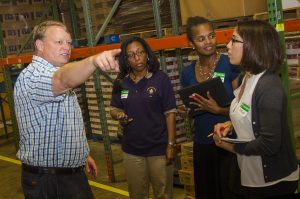
In the United States, food insecurity is a major issue. In the country, 10.5 percent of the households were food insecure in 2019, and that number increased by 29 percent in 2020 with the spread of COVID-19, according to the Feeding America
Covid-19 impact assessment. Yet, it is estimated that 30–40 percent of the food supply is wasted in the United States.
How do we provide hunger relief in the US by maximizing equitable access to safe food, while considering the food needs of food-insecure households, and simultaneously addressing redistribution of usable food that would otherwise be wasted? That is the problem to be addressed through a $2 million National Science Foundation grant by a team that is led by Culverhouse’s Dr. Irem Sengul Orgut; Dr. Julie Ivy, Dr. Munindar Singh, and Dr. Leila Hajibabai of North Carolina State University; and Dr. Lauren Davis of North Carolina A&T State University. Dr. Dwight Lewis, Dr. Emmett Lodree, and Dr. Matthew Hudnall from Culverhouse will be supporting the project.
Working with two food banks in North Carolina and one in Alabama, each serving a range of counties—together with their associated networks of food-insecure households, food-secure households, other nonprofit organizations, and local businesses such as growers, supermarkets, restaurants, and other businesses in the service regions—this project team of academic and community partners is co-developing a community-based socially intelligent nonprofit food rescue and distribution infrastructure and platform to use community resources to equitably serve food-insecure households. The platform will more equitably serve food-insecure households by continually learning their preferences with feedback to upstream stages of the supply chain.
The research team is developing three tools that will work together to achieve the goals for this project:
Smart Sociotechnical Information Capturer and Predictor: This tool will improve understanding of the behavior of donors, beneficiaries, and volunteers by creating a socially-intelligent infrastructure that records data in real-time and learns evolving stakeholders’ and end users’ needs, preferences, and utilization over time.
Tactical Supply Chain Planner: This tool will design and optimize the community food sharing network in response to stakeholder behaviors by constructing a technology and data-driven supply chain framework that adapts to evolving stakeholder behaviors to best serve the hunger needs of food-insecure households within the community.
Real-Time, Logistics Operations Optimizer: This tool will satisfy beneficiary needs through communal self-renewal by simultaneously connecting food-insecure households to community-based supply options in real-time and optimizing real-time pickup and delivery logistics while adhering to food safety time windows. The proposed infrastructure will facilitate more effective food distribution aimed at reducing hunger while simultaneously enhancing sustainability.
The research team brings together expertise in a wide range of fields including operations management, data analytics, computer science, civil engineering, and public health. Through their decade-long collaboration with a food bank in North Carolina, Dr. Sengul Orgut, Dr. Ivy, and Dr. Davis have developed tools and solutions to optimize food bank operations–the current project will build on the previous work to develop a systematic approach for rescuing food that would otherwise be wasted and distributing the food to people in need. This research promises to reduce food waste through food rescue and repurpose the food to effectively reduce hunger in a sustainable manner.
